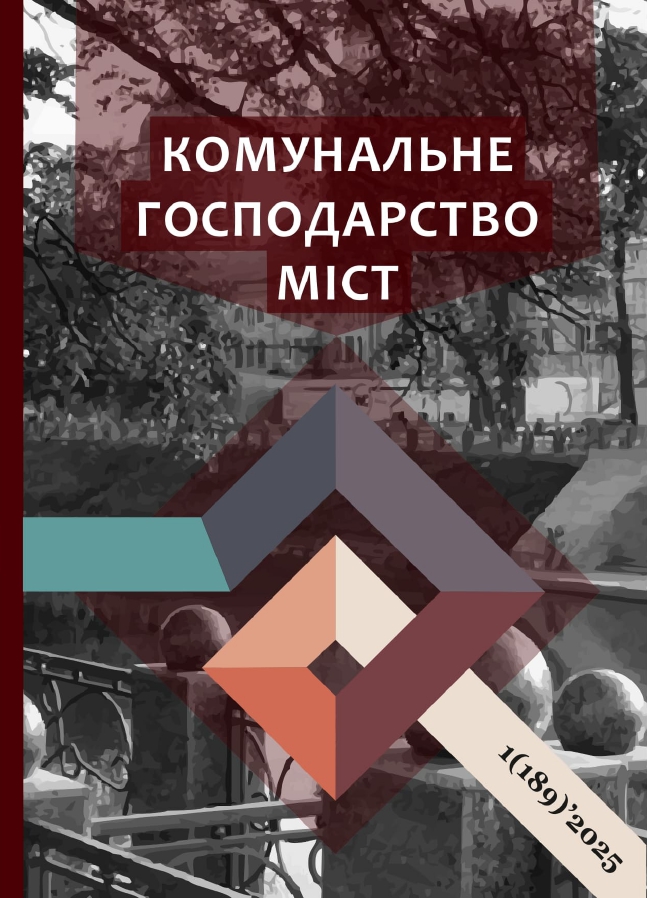PROSPECTS FOR THE DEVELOPMENT AND INTEGRATION OF MAGNESIUM BINDING MATERIALS INTO MODERN BUILDING TECHNOLOGIE
DOI:
https://doi.org/10.33042/2522-1809-2025-1-189-266-270Keywords:
CO₂ emissions, cement, magnesia binders, hardening mechanism, environmental friendliness, energy efficiency, innovative technologies, corrosion resistanceAbstract
This study highlights the prospects for the development and integration of magnesian materials into modern construction technologies. Magnesian binders exhibit a rapid setting time, low shrinkage, good adhesion to surfaces, and resistance to aggressive environments. They outperform Portland cement in terms of strength, thermal stability, and crack resistance, while their production requires less energy. During the hardening process, they absorb CO₂, reducing greenhouse gas emissions and contributing to climate change mitigation. This unique feature makes them a promising material for sustainable and eco-friendly construction practices. Magnesian materials are increasingly used in a variety of applications, including thermal insulation boards, fire-resistant coatings, decorative panels, and even in 3D printing for construction. In China, they are particularly popular due to their low cost and the abundant availability of magnesite. In the United States and Canada, magnesian binders are widely applied in fire-resistant structures, offering better durability and safety compared to traditional materials. In Ukraine, however, magnesian binders are not produced on an industrial scale, despite the country’s large reserves of dolomite, which is a primary raw material for their production. The development of this industry could significantly reduce the import of expensive cement, while also decreasing the environmental burden associated with cement production. The use of magnesian binders could become a sustainable alternative to traditional cement in construction, offering lower energy consumption, improved quality of building structures, and the ability to implement more modern and advanced technologies. Nevertheless, the widespread adoption of magnesian binders is currently hindered by a lack of investment, research, and technological advancement. Without significant state support and targeted investments in research and development, the market will remain dependent on imported analogs, and the potential of this promising material will not be fully realized. Magnesian binders could play a crucial role in the development of sustainable and energy-efficient construction solutions, contributing to the global efforts to reduce carbon footprints. The future of this technology depends on continued scientific research, the implementation of innovative approaches, and the expansion of production capacities. As the construction industry moves toward more eco-conscious practices, magnesian materials could become integral to realizing the goals of green architecture and energy-efficient building design.
References
Шабанова Г.М., Тараненкова В.В., Гапонова О.О. / Високоефективні магнезіальні в’яжучі матеріали на основі вітчизняної сировини // Збірник наукових праць Української державної академії залізничного транспорту. – 2013. – Вип. 138. – С. 148–154.
Гасан Ю.Г., Пащенко Т.М. / Будівельні матеріали // Київ: КНУБА, 2013. — 528 с.
Пушкарьова К.К., Дворкін Л.Й., Градобоєв О.В. та ін. / Енергоресурсозберігаючі мінеральні в’яжучі речовини та композиційні будівельні матеріали на їх основі // – Київ, 2014.
Гасан Ю. Г., Пащенко Т. М. / Будівельні матеріали у 2 ч. Київ // Київський національний університет будівництва та архітектури, 2013.
Саницький М.А., Соболь Х.С., Марків Т.Є. / Модифіковані композиційні цементи : монографія // Львів: ЛП, 2010.
Durastanti C., Moretti L. Environmental Impacts of Cement Production: A Statistical Analysis. Applied Sciences, 2020.
Onyekwena C.C., Xue Q., Li Q., Umeobi H.I., Ghaffar A., Fasihnikoutalab M.H. Advances in the carbonation of MgO-based binder and CO₂ utilization in the construction industry. Clean Technologies and Environmental Policy, 2023.
Building Materials Market Size, Share & Trends Analysis Report By Type (Aggregates, Bricks, Cement, Others), 2023 To 2030
Construction & Building Materials Market by Material Type (Bricks & Blocks, Concrete & Cement, Insulation Materials), Category (Architectural Materials, Auxiliary Materials, Structural Materials), Sales Channel, Application, Construction Type - Global Forecast 2025-2030
Кривенко П.В., Пушкарьова К.К., Барановський В.Б. та ін. / Будівельне матеріалознавство // — Київ: Видавництво Ліра-К, 2015. — 624 с.
Шабанова Г.М., Корогодська А.М., Христич О.В. Вʼяжучі матеріали / Практикум з дисципліни «ЗТТНСМ». - Харків: Підручник НТУ «ХПІ», 2014.
2020 Global Magnesia Refractory & Industrial Internet Promotion Conference”, China.
Плугін А.А., Плугін А.М., Кагановський О.С. та ін. / Енергоресурсозберігаючі мінеральні в’яжучі речовини та композиційні будівельні матеріали на їх основі // Київ: Наук. думка, 2012.
Лівінський О.М., Курок О.1, Пшінько О.М., Савицький М.В., Дудар І.Н., Бондаренко М.І., Хоменко О.Г., Патапова Т.Е. / Будівельні матеріали та вироби : підручник / - К. : «МП Леся», 2016.
Downloads
Published
How to Cite
Issue
Section
License
The authors who publish in this collection agree with the following terms:
• The authors reserve the right to authorship of their work and give the magazine the right to first publish this work under the terms of license CC BY-NC-ND 4.0 (with the Designation of Authorship - Non-Commercial - Without Derivatives 4.0 International), which allows others to freely distribute the published work with a mandatory reference to the authors of the original work and the first publication of the work in this magazine.
• Authors have the right to make independent extra-exclusive work agreements in the form in which they were published by this magazine (for example, posting work in an electronic repository of an institution or publishing as part of a monograph), provided that the link to the first publication of the work in this journal is maintained. .
• Journal policy allows and encourages the publication of manuscripts on the Internet (for example, in institutions' repositories or on personal websites), both before the publication of this manuscript and during its editorial work, as it contributes to the emergence of productive scientific discussion and positively affects the efficiency and dynamics of the citation of the published work (see The Effect of Open Access).

